The Art of Teaching Foreign Languages to Young Minds
Read about where language instruction becomes an enchanting adventure. In this vibrant exploration, educators discover the delicate balance between structure and creativity, guiding young learners through the rich tapestry of linguistic discovery. From fostering a love for languages to igniting curiosity and cultural appreciation, this artistry of teaching transcends mere instruction—it cultivates a lifelong passion for communication and connection. Join us in embracing the magic of language education and shaping the global citizens of tomorrow with every word spoken and lesson learned.
Have you ever paused to think about how we, as adults, approach the task of learning a foreign language compared to the sheer wonderment with which a young child discovers a new word? While foreign language teaching for older students and adults may lean on conventional wisdom and everyday conversational abilities, it’s a different ball game altogether when it comes to youngsters. Let me take you on a journey to understand this unique dynamic, and by the end, you may even find yourself reminiscing about your own childhood language experiences.
Engaging Older Students: The Bridge of Relatability
When we step into a classroom filled with teenagers or adults eager to grasp a foreign language, we have the luxury of connecting our lessons with experiences and concepts they’re already familiar with in their native language. This makes certain elements of teaching more straightforward.
For instance, if we were to discuss basic tenses (present, past, future), an adult would quickly latch on. They've spent years conjugating verbs in their own language and are already well-acquainted with the concept. Teenagers, too, can readily distinguish between formal and informal greeting phrases. They innately understand the social nuances of addressing a close friend versus a respected elder, making it easier for them to relate these differences to a foreign language.
Navigating the World of Young Learners
With children, however, the compass spins in a different direction. Their world is one of play, exploration, and boundless curiosity. Traditional lecture methods won’t suffice. Instead, lessons must be alive with activity, discovery, and immersion.
Moreover, while an older student might have an inherent passion or a practical need driving them to learn (intrinsic motivation), younger ones often lack this personal vested interest in mastering a foreign language. They are more motivated by rewards, praise, or the sheer joy of participation (extrinsic motivators). As educators, it's our task to tap into this and make each lesson as enticing as the next adventure in their favorite storybook.
A Tale of Plastic Minds
A few years ago, I was teaching a basic foreign language phrase to both an adult and a child. To the adult, who had spent decades constructing sentences a particular way in their native tongue, shifting to a new structure felt alien. On the other hand, the child, with a mind as malleable as clay, adapted instantly, curious and unburdened by years of linguistic habits.
This incident spotlighted a profound truth. The younger minds, blessed with a higher degree of "plasticity," soak in new language constructs with ease. They don’t carry the baggage of preconceived notions or entrenched habits. In essence, every lesson is a blank canvas waiting to be painted with the vibrant colors of new words and phrases.
The Silver Lining with Older Students
It's not all uphill with adults and teenagers, though. They come with a rich tapestry of experiences, which can be advantageous. Their pre-existing knowledge allows for deeper discussions and more complex language interactions. But yes, occasionally, they carry pre-existing linguistic patterns that might need a gentle nudge to align with new learning.
The Journey Ahead
Regardless of the age group we're teaching, each brings its own set of challenges and rewards. The true magic lies in tailoring our approach to resonate with the specific audience.
The Reward of Teaching Young Minds
There's an unparalleled joy in watching young students light up as they grasp a new word or phrase. Their enthusiasm, their unabashed excitement, and the pride they feel when they can use their new language skills is infectious. Young learners bring a fresh perspective, an eagerness to explore, and a genuine wonder that can reignite our own passion for teaching.
Embracing the Challenges of Older Learners
With older students, while there may be initial resistance or hesitation, the satisfaction comes from seeing their persistence. When they overcome a deeply ingrained linguistic habit or when they can confidently engage in a conversation in the new language, it's a testament to both their dedication and our teaching methods.
Our Sails
In the vast ocean of foreign language teaching, the winds can be unpredictable. Sometimes, it's a gentle breeze that guides our ship effortlessly, and at other times, we may encounter strong gusts that challenge our navigation skills. By understanding our learners – be it the playful child or the contemplative adult – and adapting our sails accordingly, we can ensure a rewarding journey for both the student and the teacher.
Taking the Next Step Together
If you're an educator looking for guidance or someone enthusiastic about foreign languages, I invite you to delve deeper into the world of language teaching with me. Book coaching sessions, explore insightful blogs, and more at rositaruiz.com. For those seeking engaging and fun language content, don't miss out on the treasures at my store on Teachers Pay Teachers. Let's navigate the beautiful intricacies of language teaching together.
The Intricacies of the Learning Process in Foreign Language Teaching
Ever tried to recall a newly learned phrase in a foreign language, only to realize it's vanished from your memory? Dive into 'The Intricacies of the Learning Process in Foreign Language Teaching' as we explore the delicate dance between teaching and genuine learning. From personal tales of Italian misadventures to the theories that shape our understanding of the classroom, journey with us to discover what truly defines 'learning' in the world of languages. 🌍✨📚
In the vast tapestry of human experiences, learning stands as one of the most intricate yet essential threads. It's an ever-evolving journey that represents our encounters with the world and how they shape our behaviors, skills, knowledge, and attitudes. Let’s get into the fascinating world of learning and uncover its mysteries and truths.
The Essence of Permanent Change
Learning isn't just about absorbing information or picking up a new skill. It's about the lasting changes these experiences create within us. Think about the myriad of phone numbers you’ve encountered in your lifetime. How many have you genuinely remembered? Those fleeting numbers you dialed once and then forgot can't be equated to genuine learning. The essence of true learning is its permanence.
Recall those stubborn childhood days, the face-offs with green veggies on the dinner plate. If you only consumed them under watchful parental eyes but scrunched up your nose at other times, did you truly learn to appreciate them? Or were you just ticking off a daily chore? Authentic learning leaves an indelible mark, ensuring the experience stays with us long after the initial encounter.
The Multifaceted Dimensions of Learning
Learning isn't a monolithic block; it takes multiple forms:
Physical Learning: Think back to the scraped knees from your first bicycle ride or the repeated attempts to get that perfect basketball shot. These aren’t mere physical activities but culminations of physical learning where the body and mind collaborate.
Social Learning: Our social perceptions and attitudes are continuously evolving. Remember the trepidation on the first day at a new school? Over time, as you made friends and interacted, your perception of the school changed. That transformation is social learning.
Emotional Learning: The highs and lows of life, the joy of achievements, and the lessons from failures all contribute to emotional learning. It's about understanding and managing our feelings.
Cognitive Learning: It involves acquiring new knowledge or skills and enhancing our thinking capability. From solving a complex math problem to understanding global politics, cognitive learning is in constant play.
Teaching vs. Learning: An Essential Dichotomy
In the educational world, an ongoing debate exists - the distinction between teaching and learning. While they might seem synonymous, there’s a profound difference.
Reflecting on my early teaching career years working as a tutor, an incident with a student named James stands out. Despite numerous strategies and teaching methods, English grammar remained a conundrum for him. One day, in exasperation, he said, “Your teaching doesn’t mean I’m learning.” It struck a chord. James highlighted a crucial insight: the efficacy of teaching is truly measured by the depth of student learning.
For educators, it’s essential to differentiate between the act of teaching and the outcome, which is learning. The size of a class, available resources, and teaching methodologies might give a facade of effective teaching. However, genuine success lies in the tangible and lasting impact on students.
Decoding Theories of Learning
To understand learning further, let’s dissect its two foundational theories: Behaviourism and Constructivism.
1. Behaviourism: At the heart of behaviourism lies a simple premise: learning is a result of interactions with our environment. It’s all about the observable behaviors and the context in which they occur.
Consider operant conditioning, a sub-theory of behaviourism. It's based on the principle that behaviors can be molded by their consequences. For instance, a student might be motivated to complete assignments on time to earn rewards, or another might study hard to avoid the consequence of failing.
2. Constructivism: This theory is a departure from the externalized view of behaviourism. It delves into the mental processes of learners, emphasizing that learners aren't passive recipients of information. Instead, they actively construct knowledge based on their experiences.
Two dominant strands of constructivism are:
Psychological Constructivism: Focuses on individual cognitive processes. For instance, a student grappling with the concept of evaporation might recall seeing a puddle dry up on a hot day. Here, personal experiences are the building blocks of understanding.
Social Constructivism: This strand posits that social interactions are pivotal for learning. Group discussions, collaborative projects, and peer feedback are instances where learners, through social interactions, achieve a richer understanding than in isolation.
The Ever-evolving Landscape of Learning
Learning is not a destination but a journey. A journey filled with myriad experiences, challenges, and revelations. Whether viewed through the prism of behaviourism, emphasizing the external environment, or constructivism, highlighting internal cognitive processes, learning remains a fascinating domain.
For educators and learners alike, understanding these nuances is invaluable. It not only enriches the teaching-learning experience but also offers insights into the multifaceted nature of human growth and evolution. As we continue to learn, we not only acquire new knowledge and skills but also pave the way for future discoveries and innovations.






